http://now.northropgrumman.com/robot-farmers-seeding-new-agricultural-revolution/
By TIM HORNYAK Mar 15th 2018
At the annual Farm Progress Show in Iowa in 2016, growers gawked at what some are describing as the beginning of a new agricultural revolution: a self-driving tractor that takes humans out of the loop entirely.
The Case IH Autonomous Concept Vehicle can go from parking spot to field and back by itself. It can be operated and monitored remotely via tablet as it follows preset paths for planting, harvesting or other farming tasks. Equipped with sensors for automatic navigation and obstacle avoidance, it can work around the clock, boosting productivity.
While the prototype turned heads because it eliminates the driver’s cab, varying amounts of automation have been incorporated into tractors and agricultural equipment for years. In fact, robots are already on the farm doing everything from seeding and harvesting to milking. Aerial drones are being used to survey and spray crops. Automated lettuce thinners, grape-leaf pullers and weed killers are taking on difficult, repetitive jobs and doing them more quickly and efficiently than human workers. Along with GPS and satellite technology used to guide tractors and map fields, these robots are part of a new farm revolution known as precision agriculture.
Many More Mouths to Feed
In a 2016 report on precision farming, Goldman Sachs said it sees a $240-billion market for automation on the farm, including a $45-billion market for small driverless tractors alone. Besides saving time and money, these robotractors would bring benefits such as a lower rate of soil compaction — which means better yields — because of their lighter weight compared to manual tractors. The report estimates that automation on the farm, along with technologies such as precision irrigation and planting, could help increase farm yields by more than 70 percent by 2050, when the global population is predicted to approach 10 billion.
“We will have a lot more people to feed than we ever have in history,” says Jonathan Rogers, assistant professor of mechanical engineering at Georgia Tech. “The only way we can really achieve the level of food production we’re going to need in the future is to employ automation and robots.”
Meeting the huge demand from so many people will require some thinking outside the box. Rogers and colleagues recently developed an agricultural robot that’s different from all the rest. Inspired by sloths and named Tarzan, the two-armed machine swings like a gibbon along parallel wires suspended above a field while imaging the crop. It’s designed to stay in the field for long periods, photographing each plant so that farmers don’t have to physically check for signs of wilting. Instead, they can remotely review imagery in real time, getting more frequent snapshots of their plants and saving them time spent on crop inspection.
Automate or Die?
With more and more robots swinging, flying and rolling around farmers’ fields, what will happen to farmers and farm workers? Ever since the original Agricultural Revolution and then the Industrial Revolution, introducing automation at the workplace has raised concerns about displacing human labor, and recent debates surrounding robotics in U.S. manufacturing are no different.
The fact is that the percentage of the U.S. workforce engaged in agriculture has diminished drastically over the past two centuries while productivity has jumped due to the introduction of machinery. As University of Georgia economics professor Jeffrey Dorfman writes, “The history of mechanization in agriculture provides proof that huge numbers of workers can be replaced by machines without leading to mass unemployment.”
In countries such as the U.S. and Japan, automation is increasingly being seen as the only way to deal with labor shortages caused by immigration crackdowns, aging populations or both.
“The trade-off isn’t, do you want a machine or do you want workers,” Michigan farmer Steve Tennes, who uses a machine that supports apple pickers, told Bloomberg in January 2017. “It’s do you want to be in business or do you not want to be in business.”




